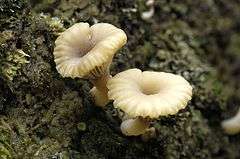Lichenomphalia
Lichenomphalia is both a basidiolichen and an agaric genus.[2][3] Most of the species have inconspicuous lichenized thalli that consist of scattered, small, loose, nearly microscopic green balls or foliose small flakes containing single-celled green algae in the genus Coccomyxa,[4] all interconnected by a loose network of hyphae. The agaric fruit bodies themselves are nonlichenized and resemble other types of omphalinoid mushrooms. These agarics lack clamp connections and do not form hymenial cystidia. The basidiospores are hyaline, smooth, thin-walled, and nonamyloid.[5] Most of the species were originally classified in the genera Omphalina or Gerronema.[6][7][8] Historically the species were classified with those other genera in the family, the Tricholomataceae together with the nonlichenized species. Lichenomphalia species can be grouped into brightly colored taxa, with vivid yellow and orange colors, versus the grey brown group, depending upon the microscopic pigmentation deposits. Molecular research comparing DNA sequences now place Lichenomphalia close to the redefined genus Arrhenia, which together with several other genera not traditionally considered to be related, fall within the newly redefined Hygrophoraceae.[9][10]
| Lichenomphalia | |
|---|---|
 | |
| Lichenomphalia umbellifera | |
| Scientific classification | |
| Kingdom: | |
| Division: | |
| Class: | |
| Order: | |
| Family: | |
| Genus: | Lichenomphalia Redhead, Lutzoni, Moncalvo & Vilgalys (2002) |
| Type species | |
| Lichenomphalia hudsoniana (H.S.Jenn.) Redhead, Lutzoni, Moncalvo & Vilgalys (2002) | |
| Species | |
|
L. alpina | |
| Synonyms[1] | |
| |
Etymology
Lichenomphalia is derived from the word lichen combined with the old, shorter, generic name Omphalia from whence the more familiar, longer, diminutive generic name Omphalina was derived. Basically it means the lichen omphalias.
Thallus names and nomenclature
Long before the connection was made between the nonlichenized agaric fruitbodies and the lichenized thalli, botanists and lichenologists named the asexual lichen thalli of Lichenomphalia species several times in a number of genera. Linnaeus in 1753 described the lichen thallus of L. umbellifera as an 'alga' named Byssus botryoides while simultaneously including the fruitbodies of L. umbellifera within his concept of Agaricus umbelliferus, the basionym for the name L. umbellifera. Byssus botryoides is the type species of the now officially rejected generic names Phytoconis and Botrydina. Acharius in 1810 described the thalli of L. hudsoniana as a lichen, Endocarpon viride, which is the type of another officially rejected name, Coriscium. The names 'Botrydina' and 'Coriscium' are often used to describe the thalli of different Lichenomphalia even though they are rejected names listed in the International Code of Botanical Nomenclature (Appendix V).[1] Prior to officially rejecting these names, the names Botrydina and Phytoconis were both applied to describe Lichenomphalia species. Hence literature on these lichenized agarics appears under a myriad of names, such as Omphalina, Gerronema, Phytoconis, Botrydina and Coriscium.
See also
References
- McNeill; et al. (2006). "International Code of Botanical Nomenclature (Vienna Code)". Regnum Vegetabile. 146: I–VI, 1–568. Archived from the original on 2012-10-06.
- Redhead, S.A.; et al. (2002a). "Phylogeny of agarics: partial systematics solutions for core omphalinoid genera in the Agaricales (euagarics)" (PDF). Mycotaxon. 83: 19–57. Archived from the original (PDF) on 2009-09-20.
- Redhead, S.A.; et al. (2002b). "Phylogeny of agarics: partial systematics solutions for bryophilous omphalinoid agarics outside of the Agaricales (euagarics)" (PDF). Mycotaxon. 82: 151–168.
- Zoller, S.; Lutzoni, F.M. (2003). "Slow algae, fast fungi: exceptionally high nucleotide substitution rate differences between lichenized fungi Omphalina and their symbiotic green algae Coccomyxa". Molecular Phylogenetics and Evolution. 29 (3): 629–640. doi:10.1016/S1055-7903(03)00215-X. PMID 14615198.
- Norvell, L.L.; et al. (1994). "Omphalina sensu lato in North America. 1-2: 1: Omphalina wynniae and the genus Chrysomphalina. 2: Omphalina sensu Bigelow". Mycotaxon. 50: 379–407.
- Lutzoni, F.M.; Vilgalys, R. (1995). "Omphalina (Basidiomycota, Agaricales) as a model system for the study of coevolution in lichenized fungi". Cryptogamic Botany. 5: 82–97.
- Lutzoni, F.M. (1997). "Phylogeny of lichen- and non-lichen-forming omphalinoid mushrooms and the utility of testing for compatibility among multiple data sets" (PDF). Systematic Biology. 46 (3): 373–406. doi:10.2307/2413688. JSTOR 2413688. PMID 11975328. Archived from the original (PDF) on 2008-10-11.
- Lutzoni, F.M.; Pagel, M. (1997). "Accelerated evolution as a consequence of transitions to mutualism" (PDF). Proceedings of the National Academy of Sciences. 94 (21): 11422–11427. doi:10.1073/pnas.94.21.11422. PMC 23487. PMID 11038586. Archived from the original (PDF) on 2007-07-29.
- Moncalvo, J-M.; et al. (2002). "One hundred and seventeen clades of euagarics" (PDF). Molecular Phylogenetics and Evolution. 23 (3): 357–400. doi:10.1016/S1055-7903(02)00027-1. PMID 12099793. Archived from the original (PDF) on October 25, 2007.
- Matheny, P.B.; et al. (2006). "Major clades of Agaricales: a multilocus phylogenetic overview". Mycologia. 98 (6): 982–995. doi:10.3852/mycologia.98.6.982. PMID 17486974.
External links
| Wikimedia Commons has media related to Lichenomphalia. |
| Wikispecies has information related to Lichenomphalia |